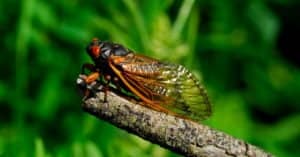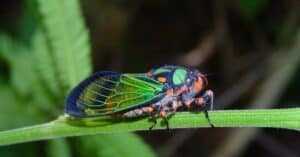Cicadas often get a bad wrap. These tiny herbivorous insects often get mistaken for locusts and while they are similar they are not the same thing. Unlike locusts, cicadas do not swarm and are generally less destructive towards crops. Cicadas belong to the superfamily Cicadoidea, and the suborder Auchenorrhyncha, which also includes leafhoppers and froghoppers. There exist more than 3,000 species of cicada worldwide, and many more are waiting to be discovered. While some cicadas emerge every year, others spend years living underground as nymphs. This unusual behavior leads many people to liken them to plagues when they eventually reappear in large numbers. They have been part of human myths and folklore for generations, and yet still so much remains unknown about them. For instance, even when pressed, many people could not answer the question, “what do cicadas eat?”
In this article, we’ll attempt to clear up some of the confusion and mystery surrounding the diet of cicadas. We’ll start off by talking about what cicadas like to eat. From there, we’ll discuss their various senses and how they forage for food. Next, we’ll compare what cicadas eat in the wild versus what they eat in captivity. Finally, we’ll end with a conversation about what baby cicadas eat. So, let’s get started and answer the question, “what do cicadas eat?”
What Do Cicadas Like to Eat?
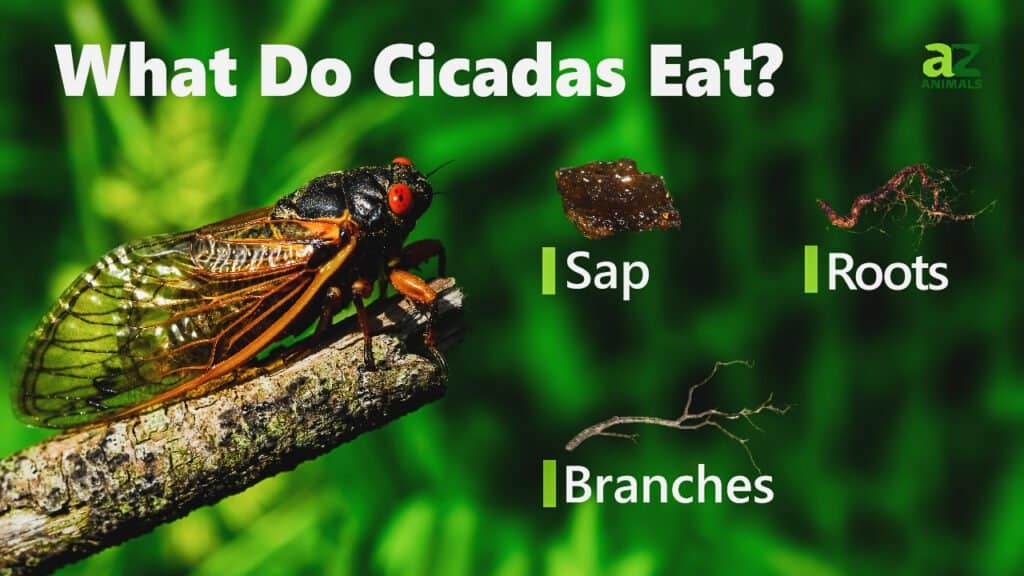
Many people mistakenly believe that cicadas can hurt them or their parts. In reality, this belief couldn’t be farther from the truth. Not only will cicadas not hurt you or your animals, but they also do not possess the ability to hurt you, because they lack the biological ability to bite. While they may look menacing with their large wings and loud, buzzing sounds, cicadas are relatively harmless to everything except plants. Cicadas are herbivores, meaning that they subsist only on plant matter. Even then, they tend to not destroy plant leaves, like locusts, making them less destructive to vegetation. Rather, their choice of foods is quite specific and varies depending on their age. Cicadas drink the sap from the xylem of plant roots, stems, twigs, and trees. In this sense, they are more similar to nectarivores such as bees than they are to herbivores like locusts.
How Do Cicadas Forage For Food?
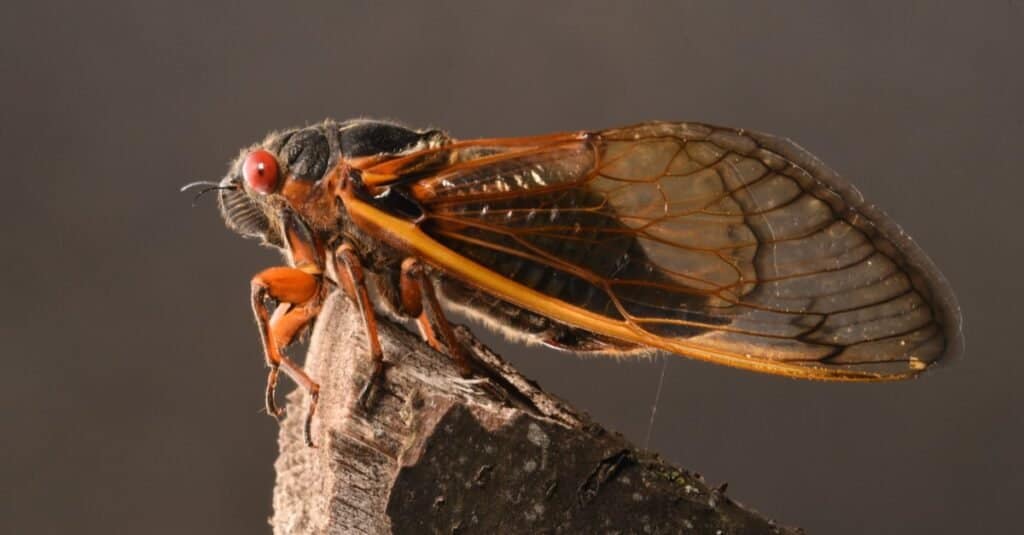
Cicadas possess 5 eyes and excellent hearing.
©1979825168/Shutterstock.com
Cicadas possess many of the senses that we’re familiar with. That said, we still understand little about their senses and how they go about finding food. To begin, we know that cicadas possess five eyes. They have two large compound eyes that they use to see objects and three simple eyes. The simple eyes, called ocelli, help them to distinguish variations in light and darkness. Additionally, cicada’s hearing abilities are well documented. They possess one of the most sophisticated auditory systems of any insect. Cicadas are well-known to be quite vocal, so their advanced hearing abilities likely explain how they communicate with one another and find each other to mate. However, it’s not entirely clear if they rely on their sight or hearing to find food. Likely, smell plays a larger role in the search for food, as they search underground for roots to suck the sap from.
As previously mentioned, cicadas are not able to bite. Instead, their mouths are in the shape of a straw, which they use to pierce plants. The outside of the beak, or rostrum, is formed by the labium. Inside the labium is the stylet, which is made up of the mandibles and maxillae. It’s these parts that pierce the roots and branches of plants. Once it has pierced a plant with its beak, a cicada will then suck up the sap inside the plant. The sap contains amino acids and minerals that the cicada then converts into energy. The larger the cicada, the bigger plants that it will target. Therefore, it’s more accurate to say that cicadas drink rather than eat because they lack the ability to chew. Once they’re done drinking, their saliva will plug up the hole they created in the plant before they move on.
What Do Cicadas Eat in the Wild?
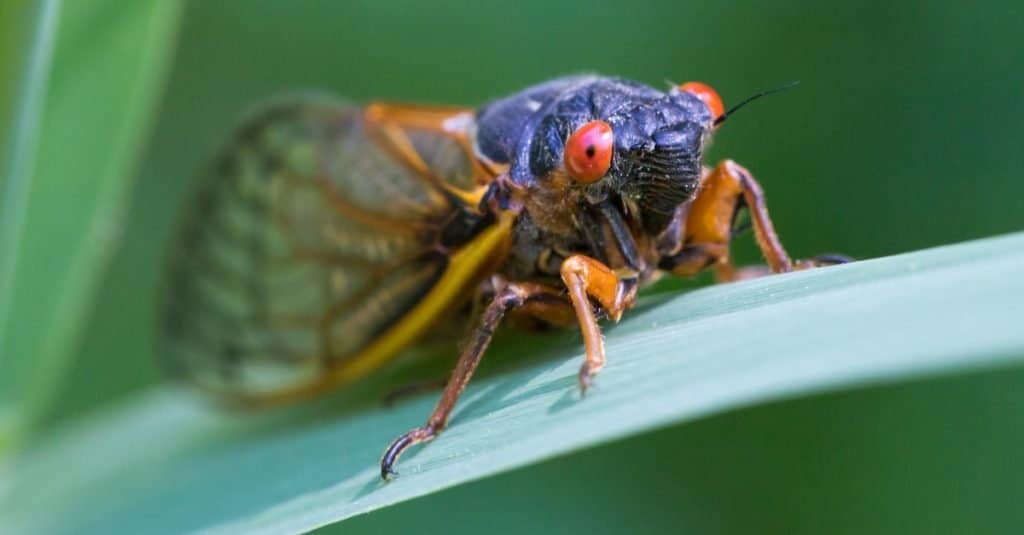
Cicadas use a straw-like appendage to suck nutritious fluids from trees and their roots to help them survive underground.
©Elliotte Rusty Harold/Shutterstock.com
In the wild, cicadas live in many different types of environments including rainforests, deserts, and woodlands. They live on every continent except Antarctica, which just goes to show how sturdy and adaptable they are. However, they tend to avoid agricultural areas, as they don’t like to be near areas where the earth is regularly plowed. Cicadas will eat the sap of various kinds of plants ranging from grasses to bushes to trees. The types of plants that they eat vary depending on their environment. For example, a cicada living in a dry desert will not eat the same sap as a cicada living in a rainforest. That said, some common trees that cicadas eat the sap of in the wild include oaks, cypress, maple, ash, and willow trees. They prefer younger trees, as well as the sap from fruit trees, hawthorn, and redbud trees.
What Do Captive Cicadas Eat?

Cicadas require access to plenty of moisture and fresh twigs if kept in captivity.
©Georgi Baird/Shutterstock.com
Some people enjoy keeping cicadas as pets, either for observation or to listen to the buzzing sounds that they make. Regardless, if you keep a cicada as a pet, you’ll need to know what to feed it to keep it alive. First, you’ll want to make sure that your cicada is in a shady, well-ventilated container and has access to plenty of water. You can soak a paper towel in water and put it in its enclosure to satisfy this requirement. As for food, you can put some thin tree branches or twigs in its enclosure. If possible, try to include a variety of twigs from trees such as oak, elm, maple, or ash. That way, the cicada gets a chance to sample the sap from different sources and gets a wide variety of minerals. Just make sure to replace the twigs in your cicadas enclosure every few days.
What Do Baby Cicadas Eat?
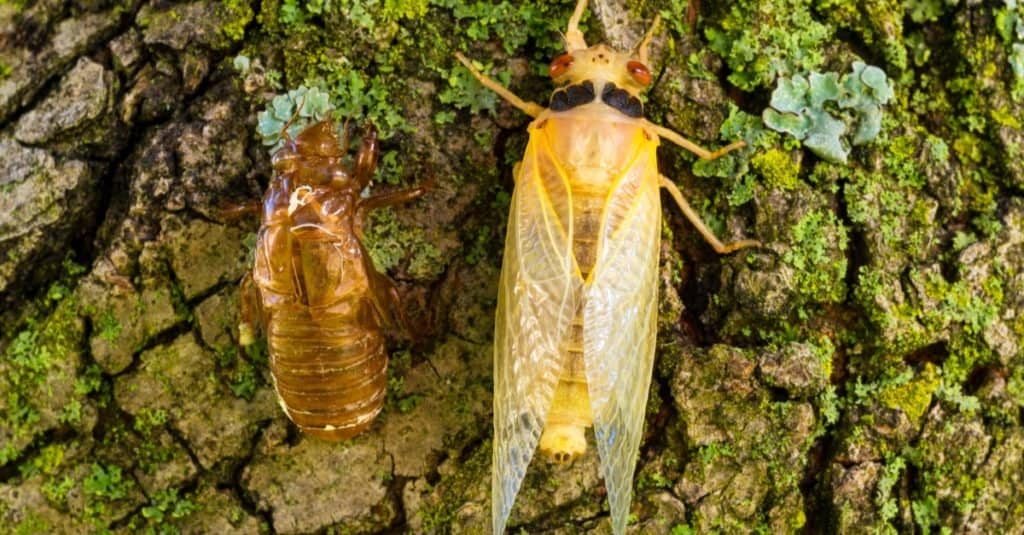
Cicadas may spend up to 17 years as nymphs before molting into adults and emerging from the ground.
©Kenneth Sponsler/Shutterstock.com
Baby cicadas, or nymphs, go through several life cycles before they become adults. In fact, a cicada spends most of its life in its juvenile state, usually living for years as a nymph but only a few weeks as an adult. Some species will spend up to 17 years underground feeding until they’re ready to emerge as adults. As nymphs, cicadas eat much of the same foods as they do as adults. The difference comes in the types of plants that they target and how they get their food. Rather than flying around from twig to twig, nymphs burrow through the ground in search of roots. They tend to target smaller, thinner rootlets of grass or young trees rather than larger roots. As they grow, they’ll move on to larger roots until they eventually emerge and target twigs and branches of trees.
The photo featured at the top of this post is © Marcos Cesar Campis/Shutterstock.com
Thank you for reading! Have some feedback for us? Contact the AZ Animals editorial team.



